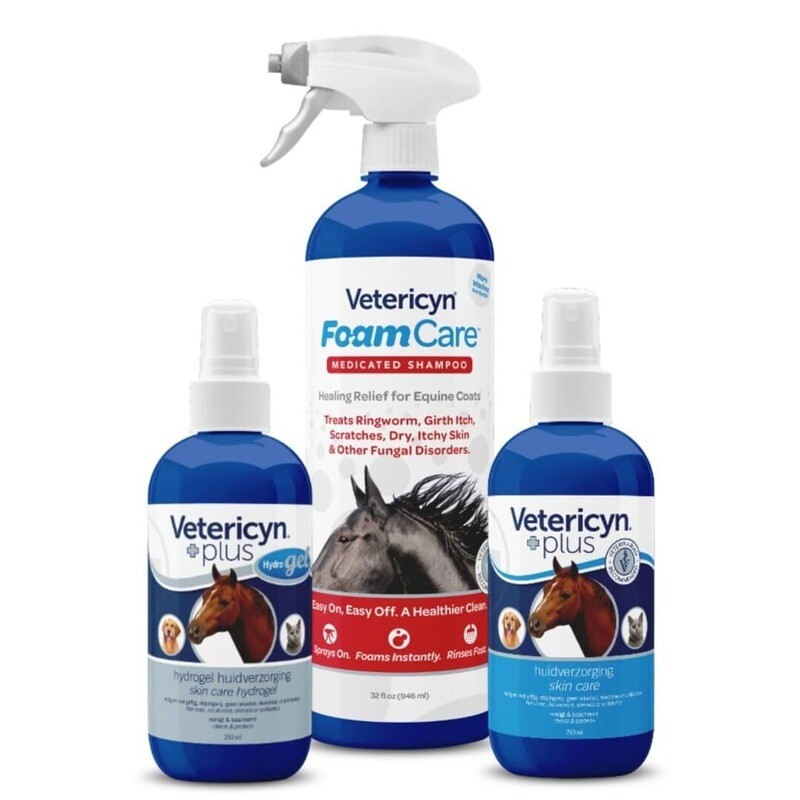Powered by Bestia Europe B.V.
Don't let ringworm tarnish your horse's beautiful coat
As a devoted horse owner, you take pride in your equine’s appearance. That’s why a sudden development of patchy, scab-ridden skin can be shocking, and leave you worried about the health and well-being of your horse. This may be a sign of horse ringworm—the most common fungal skin infection in horses.1
Despite the unsightly appearance of this skin condition, ringworm won’t cause your horse much discomfort. However, this doesn’t mean it’s completely harmless.
In this guide, we’ll discuss how to treat horse ringworm so that you can restore your horse’s coat while also stopping the spread of this highly contagious fungal infection.
What is Horse Ringworm?
Horse ringworm is caused by a fungus that thrives within damp soil. It’s often spread to horses and other animals while they’re lying down outside or rolling around in the grass. However, soil isn’t the only place this fungus likes to call home.
The ringworm fungus can live for months within wooden structures, such as horse stalls, fence posts, and railings, as well as on grooming equipment, blankets, and bedding. It’s from these surfaces that this pesky fungus can find its way onto your horse. It makes itself cozy on the warm, moist surface of your horse’s skin, and feeds off the keratin found in your horse’s hair, leading to an unsightly fungal infection that causes further skin problems.
Signs of Ringworm
Unlike other skin conditions, horse ringworm typically doesn’t cause any itching or discomfort. Although this might initially sound like great news for your horse, it makes recognizing a ringworm infection in its early stages that much harder.
When ringworm is left untreated, it can quickly spread to other areas of your horse, as well as to your horse’s stall, grooming kit, and riding tack. That’s why it is so imperative to examine your horse’s skin, bathe your horse and implement coat cleaning regularly, and take them to their veterinarian for health check-ups.
To stay ahead of a serious ringworm outbreak, pay close attention to the condition of your horse’s skin and hair. Ringworm will often start with circular, raised tufts of fur. Eventually, the hair in the middle of these raised circles will fall out. This is because ringworm feeds off the horse’s hair, weakening the hair shafts and causing them to break. Once this occurs, it will be very easy to see a ringworm patch within your horse’s coat.

Your horse may also develop:
- Scabs
- Horse scratches or abscesses
- Dry, flaky skin
- Mild irritation or redness
- Lesions
Horse ringworm is often seen where the girth or saddle lies, as the excess rubbing caused in these areas can provide an easy access point for the fungus to invade the horse’s skin. However, ringworm can easily spread to the chest, neck, shoulders, and face, especially if the horse is groomed while infected.
Diagnosis of Ringworm
If you believe your horse may have ringworm, it’s crucial to contact your vet right away. The signs of ringworm are similar to the signs of other horse skin conditions, including dermatophilosis, folliculitis, and fly allergies.
By examining your horse and taking a culture of the fungus, your vet can rule out these other skin conditions. With an accurate diagnosis, you can ensure the best treatment plan for your horse.
Ringworm Treatment for Horses
Most cases of horse ringworm will resolve themselves within six to twelve weeks.2 But this doesn’t mean you don’t have to bother with topical treatment. Far from it! Horse ringworm is highly contagious. The longer your horse suffers from this troublesome fungus, the more likely it is they will spread the infection to other horses, the surrounding environment, and even you.
Horses under five years old, elderly horses, and horses with compromised immune systems are especially susceptible to ringworm.3 To prevent a significant outbreak and reduce the severity of your horse’s infection, swift and thorough treatment is necessary.
TREATING YOUR HORSE
To combat ringworm, start by isolating your horse from other horses in your yard.4 The idea here is to contain the fungus. Not only will this help you eliminate your horse’s infection faster, but it will also prevent a more severe outbreak and reduce the risk of reinfection.
Clip away any excess hair from the infected areas on your horse. Then, gently wash these areas with an anti-fungal shampoo, like Vetericyn’s Equine Medicated Shampoo. Allow the shampoo to soak into the skin to effectively kill the fungus.
After washing, make sure to thoroughly dry your horse’s skin. Remember: fungus thrives in moist environments, so it’s important to keep the infected areas clean and dry.
TREATING YOUR ENVIRONMENT
Effective ringworm treatment doesn’t just involve your horse—it also involves your horse’s stall, grooming kit, and tack. Be sure to either disinfect or dispose of anything your horse may have come into contact with while infected.
This includes:
- Bedding
- Riding tack
- Grooming tools
- Blankets
- Their stall
- Fencing
- Stable floors
- Transport vehicles
To protect yourself from ringworm and further minimize the risk of contamination, wear gloves while treating your infected horse. You should also make sure to disinfect your boots and thoroughly wash your clothing.
Although these measures may sound extreme, they’re necessary to eliminate ringworm and stop the fungus from spreading.
Preventing Ringworm Outbreaks
Treating horse ringworm is not only time consuming—it’s expensive. Fortunately, there are steps you can take to avoid the strain a ringworm outbreak can have on you, your horse, and your wallet.
To help prevent ringworm outbreaks:
- Isolate and monitor new horses for two to three weeks before allowing them to interact with the other horses in your yard
- Ensure all horses have their own grooming kit and riding tack
- Disinfect equipment after use
- Avoid contact with strange horses
- Keep stable stalls, floors, and railings clean
- Regularly wash your horse with anti-fungal shampoo
Fight Fungus with Vetericyn
Whether you’re looking to treat or prevent horse ringworm, you can trust Vetericyn to provide the best products on the market. Not only does Vetericyn’s medicated equine shampoo eliminate the fungus that causes ringworm, but their added nutrients also boost your horse’s natural immune system, allowing for a stronger defense against other dermatological conditions.
Plus, Vetericyn’s products are all natural, so you can effectively treat your horse without compromising their safety. To keep your horse’s coat clean, shiny, and fungus-free, choose Vetericyn FoamCare Equine Shampoo.
Refine by

Vetericyn FoamCare Equine First Aid Shampoo
Vetericyn FoamCare Equine First Aid Shampoo
Hypoallergenic - Helps heal dry, itchy skin - Treats ringworm, girth itch, fungal disorders
€27,23
On Sale

Vetericyn Recover & Prevent Horse
Vetericyn Recover & Prevent Horse
Prevent and restore all common problems that lie on the skin.
was €65,17
Save 11%
€57,81
Lowest price in 30 days: €65,17
Display prices in:EUR

